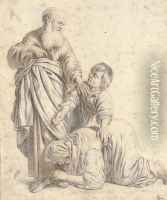Joseph De Braij Paintings
Joseph de Bray, also known as Joseph De Braij, was a Dutch painter who lived during the Dutch Golden Age. Born in 1627 in Haarlem, he was part of an artistic family; his father, Salomon de Bray, was a renowned architect and painter, and his brothers, Dirck and Jan de Bray, also pursued careers in art. Joseph de Bray excelled in painting portraits and still lifes, and he is particularly noted for his skill in depicting textures and surfaces, from the luster of metal to the delicate translucency of glass and the intricacies of fine lace.
De Bray's works, while not as widely recognized as those of some of his contemporaries, exhibit the precision and attention to detail characteristic of Dutch Golden Age painting. He often incorporated symbolic elements into his still lifes, sometimes to convey moral or religious messages, as was common among artists of his time. In addition to his own practice, de Bray was involved in the local artists' guild in Haarlem, which played a crucial role in the city's artistic community.
Unfortunately, not much is known about Joseph de Bray's personal life or his artistic career compared to other Dutch Golden Age painters. Nevertheless, his existing works contribute to the rich tapestry of 17th-century Dutch art and provide insights into the era's cultural and aesthetic values. He died in 1697, and while he may not have achieved the same level of fame as some of his peers, his artistry continues to be appreciated by those who study this period of art history.
